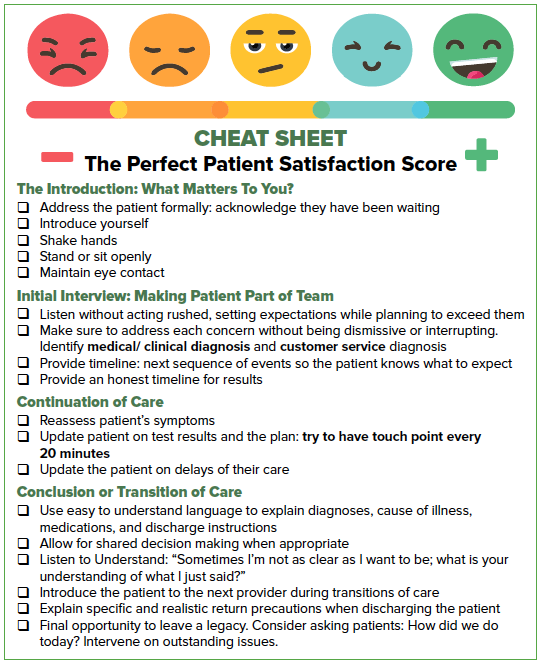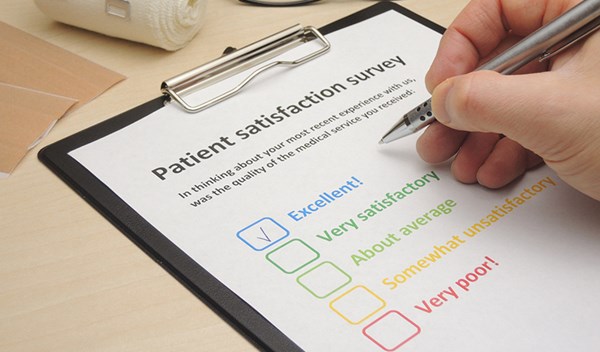Patient satisfaction is becoming an increasingly important metric in medicine. But how often are ED patients happy and satisfied? Nevertheless, it's worth knowing how to measure this important aspect of patient care.
As the U.S. health care system continues to transition to value-based reimbursement, patient satisfaction is becoming an increasingly important metric for hospitals, clinicians, and patients. From a hospital systems standpoint, it can be used to compare different health initiatives, evaluate the quality of care, and identify areas of improvement.1 From a financial perspective, it can be an essential marker of performance and compensation for hospitals, administrators, and physicians.
A study by Fullam et al. found that patients’ perceptions of quality explained nearly 30% of the variation in hospital financial performance.2 This has led to senior health care executives' compensation being tied to patient satisfaction scores, which in turn prompts administrators to incentivize (or penalize) scores.3 Moreover, patient satisfaction is important from a malpractice standpoint, where studies have shown that positive patient experience is associated with lower medical malpractice risk. In one study, they found that the likelihood of a provider being named in a malpractice suit increased by 21.7% for each drop in patient-reported scores along a 5-step scale of "very good" to "very poor".2
Patient satisfaction is also linked to greater employee satisfaction, resulting in reduced staff turnover. For instance, a focused initiative to improve the patient experience at one hospital led to a 4.7% reduction in employee turnover.4 Not only is patient satisfaction an important reflection of the quality of work we’re doing as physicians, but it can also be impactful to the health outcomes of our patients. Higher patient satisfaction has been shown to improve patients’ compliance with recommended treatments and will result in closer patient follow-up with appointments.1 And most important, measuring patient satisfaction gives patients a voice in their own healthcare, and is fundamental when striving towards patient-centered care.
Measuring Patient Satisfaction
In 2002, the federal government became involved in patient satisfaction scores with the creation of the 27-question Hospital Consumer Assessment of Healthcare Providers and Systems (HCAHPS) survey. Then in 2010, the Affordable Care Act tied hospitalized Medicare pay-for-performance with HCAHPS. As part of the Hospital Value-Based Purchasing Program, hospital performance on the HCAHPS survey can affect the hospital’s base operating Medicare payments by 2.0%, positively or negatively. To aid in capturing the HCAHPS payment, roughly 50% of hospitals use Press Ganey as the vendor of the HCAHPS survey. In addition to the financial benefit of the survey, it also provides feedback that guides hospitals in policies and allows patients to have a voice in their own healthcare. Informed by survey data, hospitals can develop initiatives to make the patient experience better in terms of effectiveness and efficiency.5
The HCAHPS survey asks about:
- communication with doctors
- communication with nurses
- responsiveness of hospital staff
- communication about medicines
- care transition
- cleanliness of the hospital environment
- quietness of the hospital environment
- discharge information
- overall hospital rating
- likelihood to recommend
In terms of doctor communication, the survey asks:
- During this hospital stay, how often did doctors treat you with courtesy and respect?
- During this hospital stay, how often did doctors listen carefully to you?
- During this hospital stay, how often did doctors explain things in a way you could understand?
However, the HCAHPS survey also has several limitations that may impact the scores. For example, taking care of critically ill patients may lower some scores due to low acuity patients potentially grading you poorly as a result of increased wait times as you were actively resuscitating and stabilizing more sick patients. Another limitation is the lapse of time between a patient’s ED visit and the receipt of a survey in the mail, which may affect a patient’s memory of their visit. And patients who were unhappy due to a long wait or because they did not receive requested medications or testing may be more inclined to show their unhappiness by down-grading all aspects of their care, even when other aspects of the care they received were exceptional. As well, certain patient dispositions may influence the attention received from providers. For instance, patients who leave without being seen or who are admitted to the observation unit do not receive surveys, leaving open the possibility that providers can change how they manage these patients to minimize poor scores.6 Herein within this context, an opportunity presents itself for emergency physicians to gain awareness of the drivers of patients satisfaction.
Determinants of Patient Satisfaction
Hospital Environment
The hospital environment has a large impact on patient satisfaction, and facility improvement can lead to improved patient scores. A systematic review by Batbaatar et al. found that the aspects of the hospital environment that were associated with patient satisfaction included: pleasantness of the atmosphere, room comfort, bedding, cleanliness, noise level, temperature convenience, lighting convenience, food service, bathroom comfort, clarity of sign and directions, arrangement of equipment and facilities, and parking. Furthermore, patients who were in appealing rooms evaluated physicians’ actions and perceived competence more favorably.1
Patient Characteristics
The characteristics of a patient can influence whether a patient is more or less likely to be satisfied with your care. Older patients are generally more satisfied than younger patients. Patients in rural areas tend to be more satisfied than those in urban areas. Health status can impact satisfaction, as patients reporting their health as poor are generally less satisfied than those who describe themselves as healthy. Conversely, religion, gender, and race have not shown to impact patient satisfaction.1
Provider Characteristics
A provider’s physical appearance is considered important for the patient experience. Physicians wearing glasses positively affects perceived warmth and competence, whereas beardedness has a negative effect on perceived warmth.7 For emergency physicians, studies have shown that patient satisfaction does not change whether a doctor wears a white coat or scrubs in the ED.8
The provider’s gender can also impact patient satisfaction. A study by Mast et al. demonstrated that patients have different expectations about female and male physicians in-line with gender stereotypes. For female physicians, they found that patients were more satisfied if the provider demonstrated more interpersonal orientation, caringness and empathy, while negatively viewing assertion or dominant behavior. For male physicians, satisfaction was greater when they showed more interpersonal distance, more expansiveness, less orientation toward the patient, more looking at the patient chart, and louder voice. It was also found that female doctors attained highest satisfaction ratings using a consultative communication style with younger and middle-aged patients, whereas male physicians reached the highest satisfaction ratings using an authoritative communication style with middle-aged and older patients.9
Nonverbal Actions
Nonverbal actions by the physician, such as smiling, eye contact and social contact can all influence a patient’s perception of their provider. Patients were more satisfied when physicians smiled more during interactions.9 As well, eye contact has been determined to be important, but the extent of its effect changes with the length of the interaction. The degree to which eye contact influences satisfaction increases when the visit length is short, but as the visit becomes longer, the effect of eye contact decreases.10 In terms of social contact, patient ratings of likability and connectedness increased with social touch, to a point, but decreased when done in excess. The study by Mast et al hypothesized that two social touches in a consultation may be ideal.9 Other nonverbal techniques that were found to have a positive association with patient satisfaction includes nodding, forward-leaning, gesturing, gazing and eyebrow lowering. On the other hand, keeping a far distance to the patient and frowning had a negative association. And no association was found for talking while doing something else or the attractiveness of provider.9

For more information on patient satisfaction scores and other areas of EM operations, consider applying for the EMRA/ ACEP Emergency Department Director's Academy (EDDA) Scholarship!
References
- Batbaatar E, Dorjdagva J, Luvsannyam A, Savino MM, Amenta P. Determinants of patient satisfaction: a systematic review. Perspectives in Public Health. 2016;137(2):89-101. doi:10.1177/1757913916634136
- Fullam F, Garman AN, Johnson TJ, Hedberg EC. The Use of Patient Satisfaction Surveys and Alternative Coding Procedures to Predict Malpractice Risk. Medical Care. 2009;47(5):553-559. doi:10.1097/mlr.0b013e3181923fd7
- Seigrist RB. Patient Satisfaction: History, Myths, and Misperceptions. AMA Journal of Medical Ethics. 2013;15(11):982-987. doi:10.1001/virtualmentor.2013.15.11.mhst1-1311.
- Rave N, Geyer M, Reeder B, Ernst J, Goldberg L, Barnard C. Radical Systems Change. Journal of Ambulatory Care Management. 2003;26(2):159-174. doi:10.1097/00004479-200304000-00008
- HCAHPS Frequently Asked Questions. https://www.pressganey.com/docs/default-source/default-document-library/hcahps-faq.pdf?sfvrsn=4. Accessed April 4, 2020.
- Mazumdar S, Jason, Horowitz J, et al. 2 2=7? Seven things you may not know about Press Ganey Statistics. Emergency Physicians Monthly. https://epmonthly.com/article/227-seven-things-you-may-not-know-about-press-gainey-statistics/. Accessed April 4, 2020.
- Fetscherin M, Tantleff-Dunn S, Klumb A. Effects of facial features and styling elements on perceptions of competence, warmth, and hireability of male professionals. The Journal of Social Psychology. 2019:1-14. doi:10.1080/00224545.2019.1671300
- Li SF, Haber M. Patient attitudes toward emergency physician attire. The Journal of Emergency Medicine. 2005;29(1):1-3. doi:10.1016/j.jemermed.2004.12.014
- Mast MS, Hall JA, Köckner C, Choi E. Physician Gender Affects How Physician Nonverbal Behavior Is Related to Patient Satisfaction. Medical Care. 2008;46(12):1212-1218. doi:10.1097/mlr.0b013e31817e1877.
- Montague E, Chen P, Xu J, Chewning B, Barrett B. Nonverbal interpersonal interactions in clinical encounters and patient perceptions of empathy. J Participat Med. 2013 Aug 14; 5:e33.



